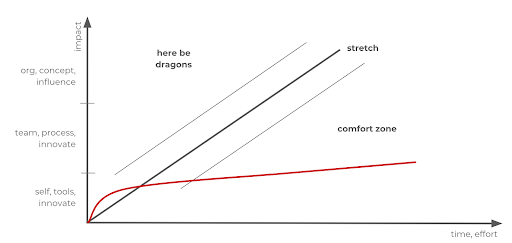Grow with experience stories
One of the most difficult but rewarding tasks in leading a UX team in a tech company is helping the team members improve to rise to the ever-increasing challenges. Even with hiring people for growth, many times the comfortable way is to stay a generalist and have a shallow overall experience. One of my biggest challenges as the team lead was to help people grow not just horizontally, but also vertically, to find everyone their “T” shape by finding stretching tasks and avoiding getting too comfortable.



Once I recognized the pattern of staying comfortable, I designed a system (a so-called UX RPG) to help people recognize their growth directions, give good feedback on skill levels, and to help us understand also the need for diversity in skills. This system was just the diagnostic tool, we needed also a way to show improvement, these were the experience stories. The stories are like portfolio pieces, but focus more on the lessons learned, and on distilling the experiences into knowledge that can be more easily reused later via storytelling. The growth plan and the charting of potential portfolio pieces have become key discussion points in later 1:1s.
Making the system work was not easy, taking the time to reflect on what happened is not a everyday practice for most people. But I believed for a strong team it’s a key muscle that needs training. I needed to work extensively with team members in their reflection process. After 2 years we already had 9 stories. It’s also clear, that the best story writers were also the high-performers of the team. Another feedback showing me the system was working, was that I got very few questions about promotions. The system was transparent to show where people are - and people stopped comparing themselves to other members of the team, but rather thought about what they can do to get better. The stories they’ve written also strengthened the sense of accomplishment and confidence of the team members.
